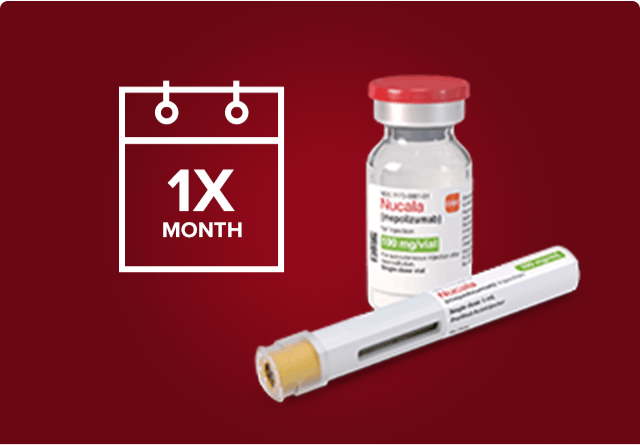ONSCREEN TEXT
An Anti-IL-5 Approved for 4 Eosinophil-Driven Diseases
Yaron Goldman, MD
Pulmonologist, Critical Care Medicine
Worcester, Massachusetts
Maeve O’Connor, MD
Allergist and Immunologist
Founder, Allergy Asthma & Immunology Relief of Charlotte
Charlotte, North Carolina
Christine Franzese, MD
Otolaryngology Professor,
Director of Allergy Department of Otolaryngology – Head and Neck Surgery at University of Missouri-Columbia
Columbia, Missouri
Drs. O'Connor, Goldman, and Franzese were paid consultants for GSK at the time of filming.
DR. O’CONNOR:
Hello, I’m Dr. Maeve O'Connor, allergist immunologist from Charlotte, North Carolina. In this video series, we will discuss NUCALA (mepolizumab), an anti-IL-5 therapy approved for 4 eosinophil-driven diseases: severe eosinophilic asthma, chronic rhinosinusitis with nasal polyps, eosinophilic granulomatosis with polyangiitis, and hypereosinophilic syndrome.
ONSCREEN TEXT
The Role of Eosinophils in SEA and the MOA of NUCALA (mepolizumab)
DR. O’CONNOR:
In the first chapter of this video series, I will discuss the role of eosinophils in severe eosinophilic asthma and the mechanism of action of NUCALA. In chapter 2, my colleague Dr. Yaron Goldman, a critical care pulmonologist, will review the efficacy and safety data of NUCALA for patients with severe eosinophilic asthma. In chapter 3, Dr. Christine Franzese, from the Department of Otolaryngology - Head and Neck Surgery at the University of Missouri-Columbia, will discuss NUCALA for chronic rhinosinusitis with nasal polyposis. And then lastly, in chapter 4, I will discuss the similarities and differences between EGPA and HES.
Before we get started, the narrator will review the Indications and Important Safety Information for NUCALA.
ONSCREEN TEXT
INDICATIONS AND IMPORTANT SAFETY INFORMATION
SEA
add-on maintenance treatment of adult and pediatric patients aged 6 years and older with severe asthma and with an eosinophilic phenotype. NUCALA is not indicated for the relief of acute bronchospasm or status asthmaticus.
CRSwNP
add-on maintenance treatment of chronic rhinosinusitis with nasal polyps (CRSwNP) in adult patients 18 years of age and older with inadequate response to nasal corticosteroids.
EGPA
treatment of adult patients with eosinophilic granulomatosis with polyangiitis (EGPA).
HES
treatment of adult and pediatric patients aged 12 years and older with hypereosinophilic syndrome (HES) for greater than or equal to 6 months without an identifiable nonhematologic secondary cause.
IMPORTANT SAFETY INFORMATION
CONTRAINDICATIONS
Known hypersensitivity to mepolizumab or excipients.
Additional Important Safety Information will be presented later in this video.
Please see full Prescribing Information and Patient Information for NUCALA at the adjacent links or visit NucalaHCP.com.
NUCALA injection is available as a 100-mg/mL vial, autoinjector, and prefilled syringe.
NARRATOR:
NUCALA is indicated for the:
- add-on maintenance treatment of adult and pediatric patients aged 6 years and older with severe asthma and with an eosinophilic phenotype. NUCALA is not indicated for the relief of acute bronchospasm or status asthmaticus.
- add-on maintenance treatment of chronic rhinosinusitis with nasal polyps (CRSwNP) in adult patients 18 years of age and older with inadequate response to nasal corticosteroids.
- treatment of adult patients with eosinophilic granulomatosis with polyangiitis (EGPA).
- treatment of adult and pediatric patients aged 12 years and older with hypereosinophilic syndrome (HES) for greater than or equal to 6 months without an identifiable non-hematologic secondary cause.
Contraindications: Known hypersensitivity to mepolizumab or excipients.
Additional Important Safety Information will be presented later in this video.
DR. O’CONNOR:
As a reminder, in this chapter, I will discuss only the severe eosinophilic asthma indication.
Eosinophils are important immune cells responsible for tissue regeneration and repair as well as host protection. However, too many airway tissue eosinophils in patients with severe asthma is associated with increased symptoms, greater likelihood for exacerbations, and airway inflammation.
ONSCREEN TEXT
Eosinophils Can Drive Inflammation in Asthma1,2
74% - 84% of patients with severe asthma had evidence of an eosinophilic phenotype in the International Severe Asthma Registry3*
*International Severe Asthma Registry: 84% of adults were identified as "most likely" to have an eosinophilic phenotype in the prospective analysis (N=1716) using a predefined algorithm: ≥ 1 : blood eosinophil count ≥300 cells/μL; anti-IL-5/5R therapy; blood eosinophil count ≥150- 300 cells/μL with maintenance OCS; or ≥2: nasal polyps, elevated FeNO, late-onset asthma. 74% were identified in a retrospective analysis of medical records in the USA (N=1891).3
DR. O’CONNOR:
Eosinophils can drive inflammation in asthma. Seventy-four to 84% of patients with severe asthma had evidence of an eosinophilic phenotype in the International Severe Asthma Registry.
Severe eosinophilic asthma is a distinct phenotype of severe asthma. The SEA phenotype can include airway inflammation, increased eosinophil levels, poor asthma control, and increased rate of exacerbations.
An eosinophilic phenotype can be considered in severe asthma patients with blood eosinophils greater than or equal to 150 cells per microliter.
ONSCREEN TEXT
Eosinophils Airway Inflammation in Asthma4
ALLERGIC eosinophilic airway inflammation
[image of allergic eosinophilic airway inflammation pathway]
NON-ALLERGIC eosinophilic airway inflammation
[image of non-allergic eosinophilic airway inflammation pathway]
Elevated eosinophils are a key driver of asthma pathophysiology1,2
IL-5 is the major cytokine responsible for the growth differentiation, recruitment, activation, and survival of eosinophils.
DR. O’CONNOR:
As you see in this figure, there are allergic and non-allergic pathways in eosinophilic airway inflammation in asthma.
Elevated eosinophils are a key driver of asthma pathophysiology.
Eosinophils release a range of cytokines and chemokines that contribute to the pathophysiology of asthma.
IL-5 is the major cytokine responsible for the growth differentiation, recruitment, activation, and survival of eosinophils.
ONSCREEN TEXT
NUCALA (mepolizumab) Inhibits IL-5, With Rapid Reduction in Blood Eosinophils5,6
NUCALA is a humanized IL-5 antagonist monoclonal antibody.
[image of How NUCALA works]
The MOA of mepolizumab has not been definitively established.
- NUCALA binds to IL-5 and blocks its binding to the alpha chain of the IL-5 receptor complex on the eosinophil cell surface
- This inhibits IL-5 signaling and reduces the production and survival of eosinophils
NUCALA reduced blood eosinophils by 74% within 48 hours.6†
Results are descriptive. The clinical significance of these pharmacodynamics data is unknown.
†Data based on mepolizumab 75 mg IV (n=10) at first measurement post-dose from a phase 2 study in 70 adult patients with asthma and blood eosinophil counts ≥200 cells/μL (mean baseline blood eosinophils: 348 cells/μL).5,6 Blood eosinophil reduction data were based on geometric mean.
DR: O’CONNOR:
NUCALA is a humanized IL-5 antagonist monoclonal antibody that binds to IL-5 and blocks its binding to the alpha chain of the IL-5 receptor complex on the eosinophil cell surface. This inhibits IL-5 signaling and reduces the production and survival of eosinophils.
Please note that the mechanism of action of mepolizumab has not been definitively established.
Data based on a phase 2 study show that NUCALA reduced blood eosinophils by 74% within 48 hours. These results are descriptive. The clinical significance of these pharmacodynamics data is unknown.
DR: O’CONNOR:
Now, please listen as the narrator presents additional Important Safety Information for NUCALA.
ONSCREEN TEXT:
IMPORTANT SAFETY INFORMATION (cont’d)
WARNINGS AND PRECAUTIONS.
Hypersensitivity Reactions:
Hypersensitivity reactions (eg, anaphylaxis, angioedema, bronchospasm, hypotension, urticaria, rash) have occurred with NUCALA (mepolizumab). These reactions generally occur within hours of administration but can have a delayed onset (ie, days). Discontinue If a hypersensitivity reaction occurs.
Acute Asthma Symptoms or Deteriorating Disease: NUCALA should not be used to treat acute asthma symptoms, acute exacerbations, or acute bronchospasm.
Opportunistic Infections: Herpes Zoster: Herpes zoster infections have occurred in patients receiving NUCALA. Consider vaccination if medically appropriate.
Please see Important Safety Information for NUCALA throughout this video.
Please see full Prescribing Information and Patient Information for NUCALA at the adjacent links or visit NucalaHCP.com.
NARRATOR:
IMPORTANT SAFETY INFORMATION, continued.
WARNINGS AND PRECAUTIONS.
Hypersensitivity Reactions:
Hypersensitivity reactions (for example, anaphylaxis, angioedema, bronchospasm, hypotension, urticaria, rash) have occurred with NUCALA. These reactions generally occur within hours of administration but can have a delayed onset (that is, days). Discontinue If a hypersensitivity reaction occurs.
Acute Asthma Symptoms or Deteriorating Disease: NUCALA should not be used to treat acute asthma symptoms, acute exacerbations, or acute bronchospasm.
Opportunistic Infections: Herpes Zoster: Herpes zoster infections have occurred in patients receiving NUCALA. Consider vaccination if medically appropriate.
ONSCREEN TEXT:
IMPORTANT SAFETY INFORMATION (cont’d)
WARNINGS AND PRECAUTIONS (cont’d)
Reduction of Corticosteroid Dosage: Do not discontinue systemic or inhaled corticosteroids abruptly upon initiation of therapy with NUCALA. Decreases in corticosteroid doses, if appropriate, should be gradual and under the direct supervision of a physician. Reduction in corticosteroid dose may be associated with systemic withdrawal symptoms and/or unmask conditions previously suppressed by systemic corticosteroid therapy.
Parasitic (Helminth) Infection: Treat patients with pre-existing helminth infections before initiating therapy with NUCALA. If patients become infected while receiving NUCALA and do not respond to anti-helminth treatment, discontinue NUCALA until infection resolves.
Please see Important Safety Information for NUCALA throughout this video.
Please see full Prescribing Information and Patient Information for NUCALA at the adjacent links or visit NucalaHCP.com.
NARRATOR:
Reduction of Corticosteroid Dosage: Do not discontinue systemic or inhaled corticosteroids abruptly upon initiation of therapy with NUCALA. Decreases in corticosteroid doses, if appropriate, should be gradual and under the direct supervision of a physician. Reduction in corticosteroid dose may be associated with systemic withdrawal symptoms and/or unmask conditions previously suppressed by systemic corticosteroid therapy.
Parasitic (Helminth) Infection: Treat patients with pre-existing helminth infections before initiating therapy with NUCALA. If patients become infected while receiving NUCALA and do not respond to anti-helminth treatment, discontinue NUCALA until infection resolves.
ONSCREEN TEXT:
IMPORTANT SAFETY INFORMATION (cont’d)
ADVERSE REACTIONS
The most common adverse reactions (≥5%) in patients receiving NUCALA (mepolizumab):
- Severe asthma trials: headache, injection site reaction, back pain, fatigue.
- CRSwNP trial: oropharyngeal pain and arthralgia.
- EGPA and HES trials (300 mg of NUCALA): no additional adverse reactions were identified to those reported in severe asthma clinical trials
Systemic reactions, including hypersensitivity, occurred in clinical trials in patients receiving NUCALA. Manifestations included rash, pruritus, headache, myalgia, flushing, urticaria, erythema, fatigue, hypertension, warm sensation in trunk and neck, cold extremities, dyspnea, stridor, angioedema, and multifocal skin reaction. A majority of systemic reactions were experienced the day of dosing.
Please see Important Safety Information for NUCALA throughout this video.
Please see full Prescribing Information and Patient Information for NUCALA at the adjacent links or visit NucalaHCP.com
NARRATOR:
ADVERSE REACTIONS: The most common adverse reactions, defined as greater than or equal to 5%, in patients receiving NUCALA in the severe asthma trials were headache, injection site reaction, back pain, fatigue. Those in the CRSwNP trial were oropharyngeal pain and arthralgia. In the EGPA and HES trials with 300 mg of NUCALA, no additional adverse reactions were identified to those reported in severe asthma clinical trials.
Systemic reactions, including hypersensitivity, occurred in clinical trials in patients receiving NUCALA. Manifestations included rash, pruritus, headache, myalgia, flushing, urticaria, erythema, fatigue, hypertension, warm sensation in trunk and neck, cold extremities, dyspnea, stridor, angioedema, and multifocal skin reaction. A majority of systemic reactions were experienced the day of dosing.
ONSCREEN TEXT:
IMPORTANT SAFETY INFORMATION (cont’d)
USE IN SPECIFIC POPULATIONS
The data on pregnancy exposures are insufficient to inform on drug-associated risk. Monoclonal antibodies, such as mepolizumab, are transported across the placenta in a linear fashion as the pregnancy progresses; therefore, potential effects on a fetus are likely to be greater during the second and third trimesters.
Please see Important Safety Information for NUCALA throughout this video.
Please see full Prescribing Information and Patient Information for NUCALA at the adjacent links or visit NucalaHCP.com
NARRATOR:
USE IN SPECIFIC POPULATIONS:
The data on pregnancy exposures are insufficient to inform on drug-associated risk. Monoclonal antibodies, such as mepolizumab, are transported across the placenta in a linear fashion as the pregnancy progresses; therefore, potential effects on a fetus are likely to be greater during the second and third trimesters.
Please see full Prescribing Information and Patient Information for NUCALA at the adjacent links or visit NucalaHCP.com.
ONSCREEN TEXT:
This program is sponsored by GSK. Thank you for your participation.
Presentation intended for US healthcare providers only.
[GSK logo]
Trademarks are owned by or licensed to the GSK group of companies.
©2023 GSK or licensor.
MPLVID230001 April 2023
Produced in USA.
NARRATOR:
This program is sponsored by GSK. Thank you for your participation.
ONSCREEN TEXT:
Acronyms
CRSwNP=chronic rhinosinusitis with nasal polyps; EGPA=eosinophilic granulomatosis with polyangiitis; FeNO=fractional exhaled nitric oxide; HES=hypereosinophilic syndrome; IL=interleukin; IV=intravenous; MOA=mechanism of action; OCS=oral corticosteroids; SEA=severe eosinophilic asthma.
ONSCREEN TEXT:
References
- Varricchi G, Bagnasco D, Borriello F, Heffler E, Giorgio WC. Interleukin-5 pathway inhibition in the treatment of eosinophilic respiratory disorders: evidence and unmet needs. Curr Opin Allergy Clin Immunol. 2016;16(2):186-200.
- Park YM, Bochner BS. Eosinophil survival and apoptosis in health and disease. Allergy Asthma Immunol Res. 2010;2(2):87-101.
- Heaney LG, Perez de Llano, Al-Ahmad A, et al. Eosinophilic and noneosinophilic asthma an expert consensus framework to characterize phenotypes in a global real-life severe asthma cohort. Chest. 2021;160(3):814-830.
- Brusselle GG, Joos G. Is there a role for macrolides in severe asthma? Curr Opin Pulm Med. 2014;20(1):95-102.
- Pouliquen IJ, Kornmann O, Barton SV, Price JA, Ortega HG. Characterization of the relationship between dose and blood eosinophil response following subcutaneous administration of mepolizumab. Int J Clin Pharmacol Ther. 2015;53(12):1015-1027.
- Data on file, GSK.
ONSCREEN TEXT:
Chapter 1 Voiceover References:
- Weller PF, Spencer LA. Functions of tissue-resident eosinophils. Nat Rev Immunol. 2017;17(12):746-760.
- Wenzel S. Severe asthma in adults. Am J Respir Crit Care Med. 2005;172:149-160.
- Malinovschi A, Fonseca JA, Jacinto T, Alving K, Janson C. Exhaled nitric oxide levels and blood eosinophil counts independently associate with wheeze and asthma events in National Health and Nutrition Examination Survey subjects. J Allergy Clin Immunol. 2013;132(4):821- 827.e1-5.
- Varricchi G, Bagnasco D, Borriello F, Heffler E, Giorgio WC. Interleukin-5 pathway inhibition in the treatment of eosinophilic respiratory disorders: evidence and unmet needs. Curr Opin Allergy Clin Immunol. 2016;16(2):186-200.
- Park YM, Bochner BS. Eosinophil survival and apoptosis in health and disease. Allergy Asthma Immunol Res. 2010;2(2):87-101.
- Heaney LG, Perez de Llano, Al-Ahmad A, et al. Eosinophilic and noneosinophilic asthma an expert consensus framework to characterize phenotypes in a global real-life severe asthma cohort. Chest. 2021;160(3):814-830.
- Global Initiative for Asthma (GINA). Global Strategy for Asthma Management and Prevention. 2021 update. 1-217.
- Brusselle GG, Joos G. Is there a role for macrolides in severe asthma? Curr Opin Pulm Med. 2014;20(1):95-102.
- Data on file, GSK.















